It is early September and our 45-year old wildlife garden should be beckoning me out the door to enjoy drifts of blooms, butterflies dashing about, and countless other pollinators.
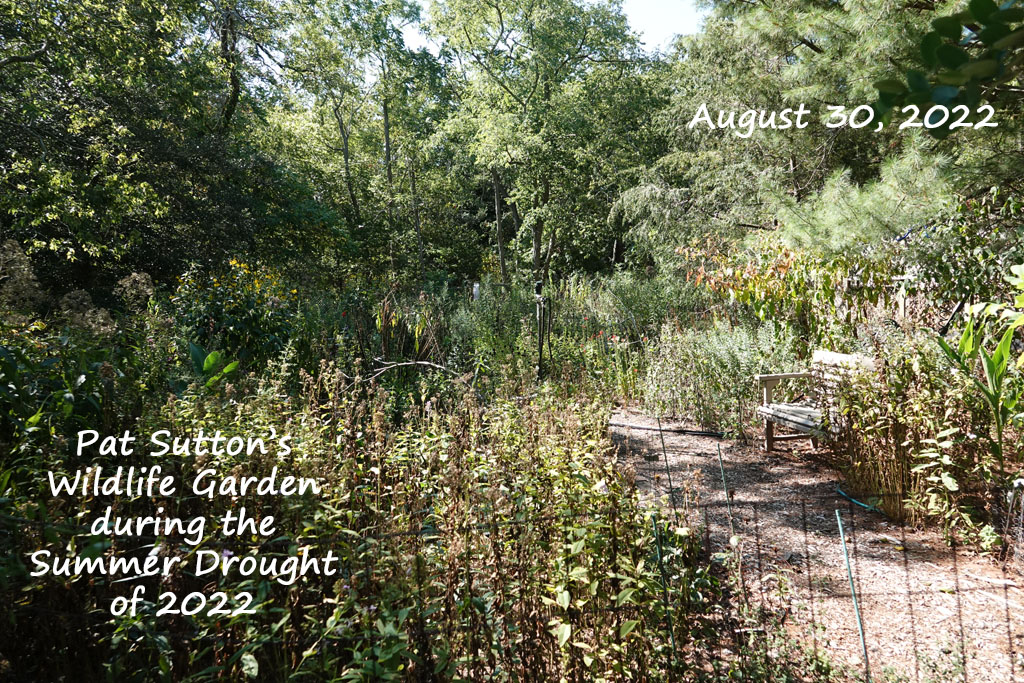
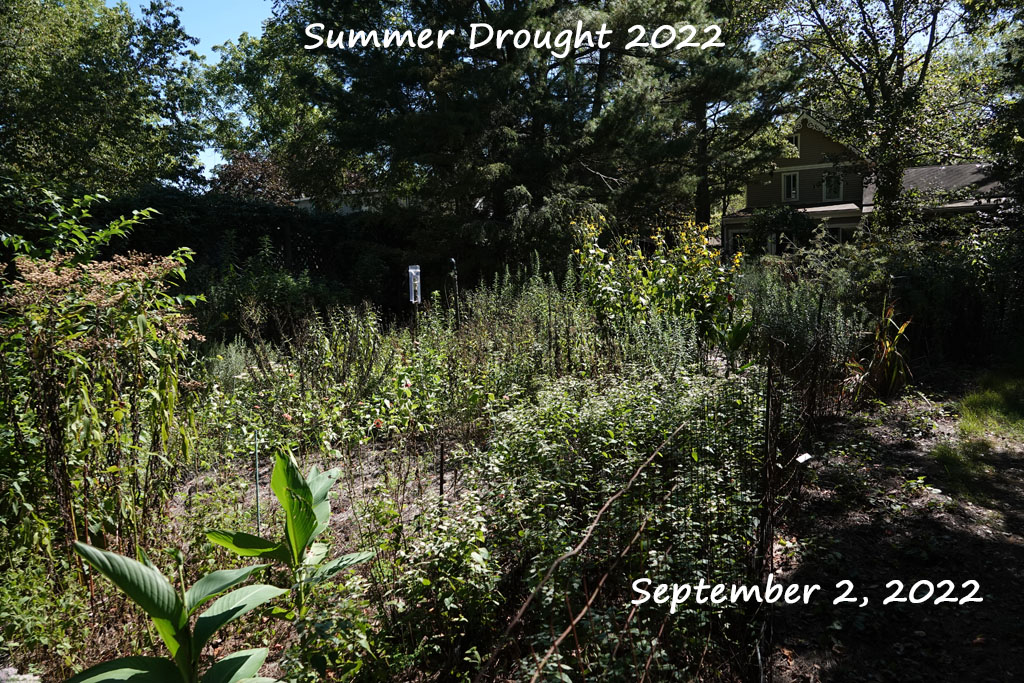 Instead the garden and yard are mostly brown with very little blooming. Buds are forming on fall blooming goldenrods and asters, thankfully, so there will be some color and nectar and pollinators to come. But for right now our wildlife garden and yard is sadly depressing. Blooms are scarce and butterflies and other pollinators are too. Tree and shrub leaves are curled up and / or falling like late fall leaves. As one who has keenly studied pollinators, I fear that many butterfly and moth caterpillars have succumbed or fallen from food sources (while attached to dead and dying leaves). Next year’s butterfly populations (and probably populations for years to come) will certainly be affected.
Instead the garden and yard are mostly brown with very little blooming. Buds are forming on fall blooming goldenrods and asters, thankfully, so there will be some color and nectar and pollinators to come. But for right now our wildlife garden and yard is sadly depressing. Blooms are scarce and butterflies and other pollinators are too. Tree and shrub leaves are curled up and / or falling like late fall leaves. As one who has keenly studied pollinators, I fear that many butterfly and moth caterpillars have succumbed or fallen from food sources (while attached to dead and dying leaves). Next year’s butterfly populations (and probably populations for years to come) will certainly be affected.
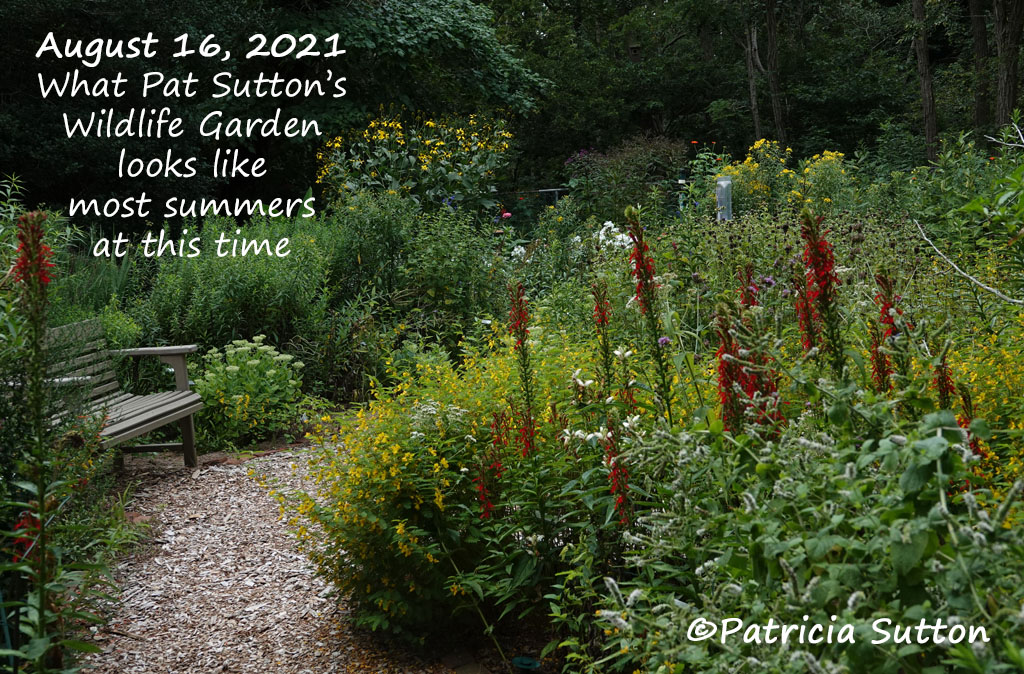
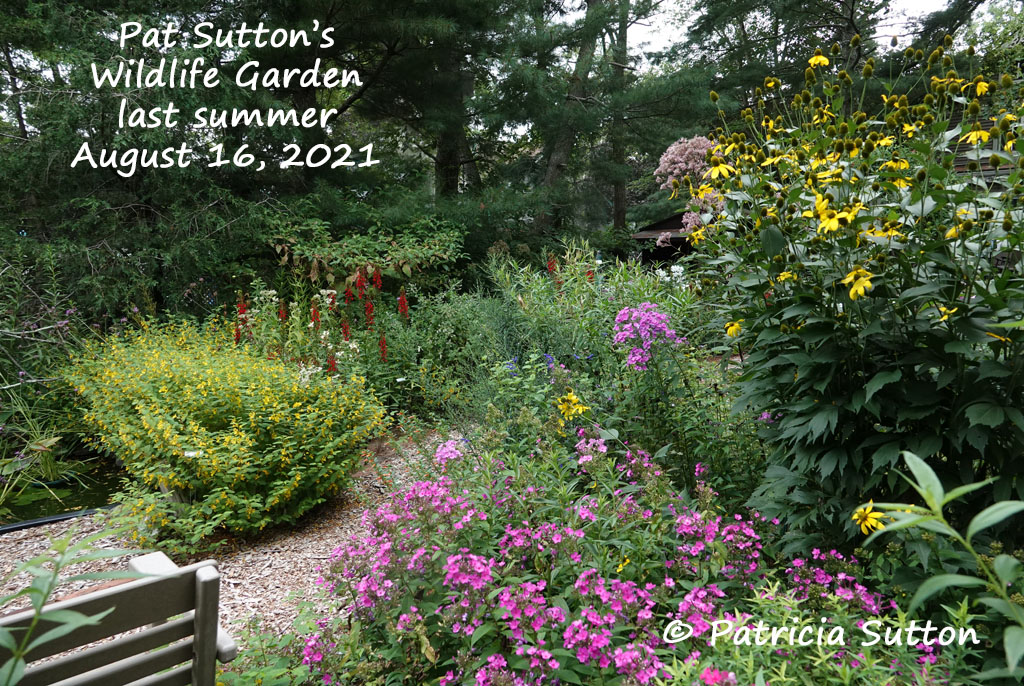 Just last summer (and most summers) this is what our garden looks like.
Just last summer (and most summers) this is what our garden looks like.
Goshen, in Cape May County, NJ, has experienced a severe drought this summer. Joe Martucci, the Meteorologist for the Press of Atlantic City, recently put it into perspective with the following key points: (1) 2022 began with a deficit of rainfall since last winter, (2) it was the 3rd driest July in 100 years, (3) it was the driest summer since 1966, (4) it was the 3rd hottest summer on record (since 1895), and (5) it was the hottest August on record. Couple all of that with our yard’s lack of rainfall and it is a wonder anything is alive.
Since October 2013 I have been a volunteer weather observer with CoCoRaHS (the Community Collaborative Rain, Hail, and Snow Network), a nationwide legion of volunteer data collectors. So I have accurate rainfall data for our yard. Too, CoCoRaHS provides comparative 30 Year Average by PRISM rainfall for our area. The numbers this summer are scary. We saw 7.1” less rainfall this summer (June, July, and August) than the 30 year average. That is mega!
RAINFALL 30 Yr Avg 2022
By PRISM Sutton Yard
June 3.26” 0.84”
July 3.86” 2.45”
Aug 4.34” 1.07”
TOTAL 11.46” 4.36”
How to Cope with Drought:
- Plant NATIVES. If this concept is new to you, read Doug Tallamy’s books. My “Gardening for Pollinators” handout (click HERE) directs you to many resources to help you select the most important (to wildlife) and suitable (to your site, soils, and conditions) natives for your area.
- When establishing a pollinator garden, set up a watering system to keep your wildlife garden alive during severe drought so you and pollinators do not lose nectar sources (and host plants for future generations). During droughts when natural areas are crisped, our tended gardens may provide the only nectar! This same watering system will make it easy to water new plantings (until they get established). Realize that even natives need some assist when first planted and during severe drought.
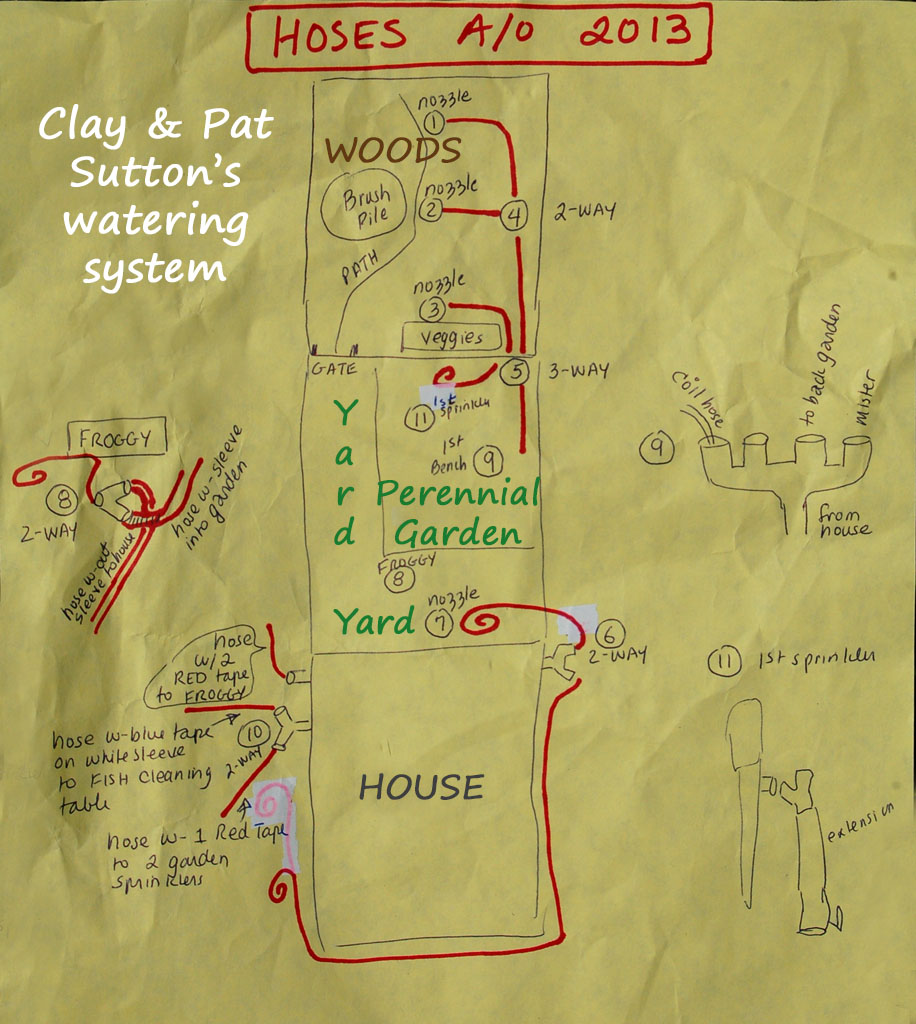
3. Incorporate rain barrels into your landscape. I’ve set up two rain barrels (one at each end of our back roof) and have two hoses from each running out into the garden where I’ve planted native perennials that like “wet feet”: Cardinal Flower, Swamp Milkweed, White Turtlehead, Turk’s-Cap Lily, Red Beebalm, Common Boneset, etc. I am very grateful for the rain barrels and what they accomplish; much of the year they stand empty.
4. Plant native trees and shrubs in fall (rather than spring) when rains and snows are more likely. This way new plantings will get the rainfall they need to get established and be less stressed. Summer plantings can be done, but only with lots and lots of watering during dry stretches. Spring plantings should be fine unless our “new normal” includes regular summer droughts.
5. If you plan to travel (or be away for lengthy periods like we were) in summer, make arrangements with a friend to water if there is no natural rainfall. Summer travel is much of the reason our garden is so baked (all told we were away for 31 days).
6. If plants look dead, don’t give up on them too soon. Cut off dead growth so the plants instead can focus on supporting live and/or new growth. Hopefully the roots have some life left. Wait until next spring to see. You might be pleasantly surprised by the resiliency of native plants.
CoCoRaHS, the Community Collaborative Rain, Hail, and Snow Network
Years ago I began keeping my own rainfall records because I quickly learned that available rainfall data shared in the local newspaper from nearby towns was inches different from the rainfall in my own yard. A gardening friend alerted me to CoCoRaHS (click HERE). I joined CoCoRaHS, bought their official rain gauge, put it up, and became part of the team. 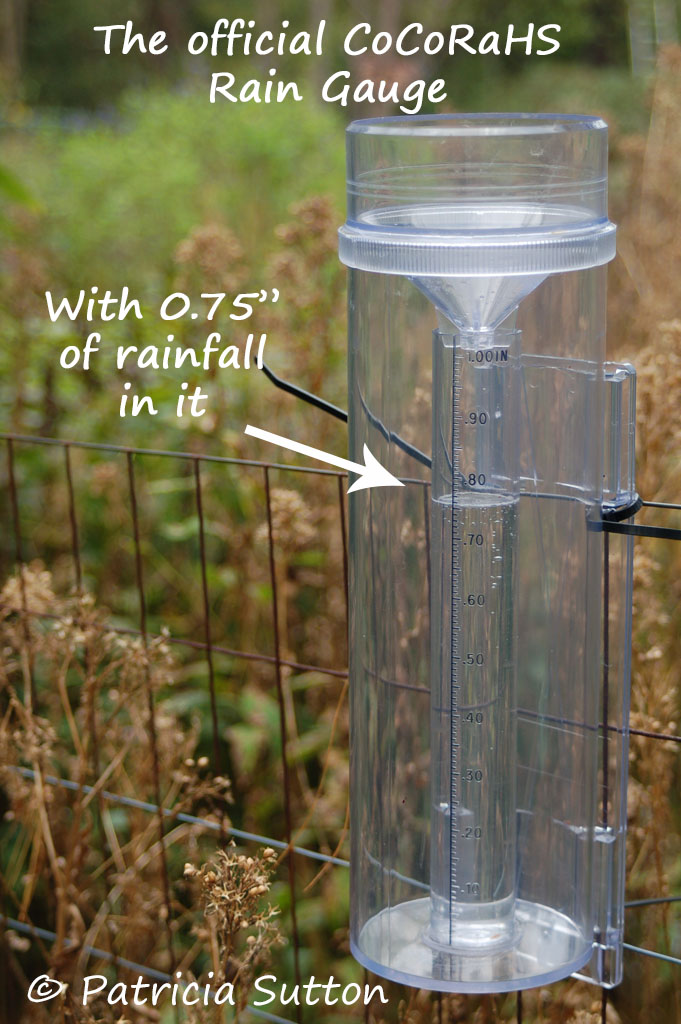
A friend who lives three miles away joined CoCoRaHS the same day and we began logging in our data simultaneously. Immediately it was evident how different the rainfall was just three miles apart. For example, on October 13, 2013, my gauge held 0.75 inches of rain and three miles away my friend’s gauge held 1.29 inches of rain. Who would have thunk?
Consider joining CoCoRaHS, a great citizen science project. Let your friends, co-workers, and family know about it so more and more sites can be added to the data. Imagine what we all can learn together.
On CoCoRaHS’s website you can look at the entire country, your region, state, or county and see the rainfall recorded by the network of observers on any given day, month, or year-to-date. It’s fascinating if you’re a keen gardener and/or a weather geek.
If you have any comments or questions, please use the “Comment” option at the end of this post, so others can benefit from everyone’s comments, questions, tips, and answers.

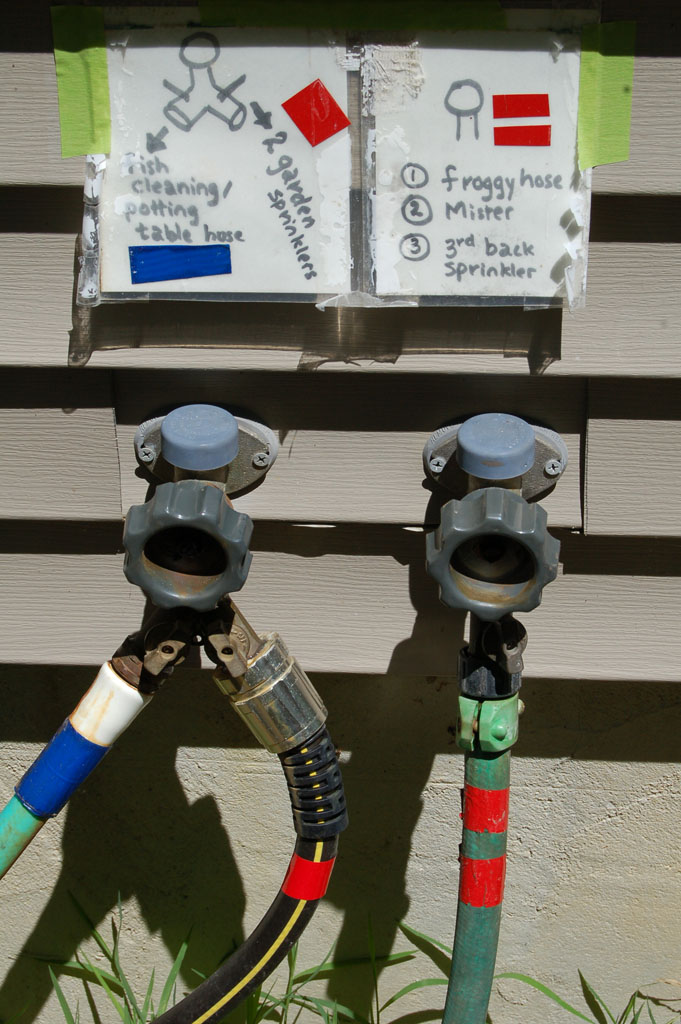
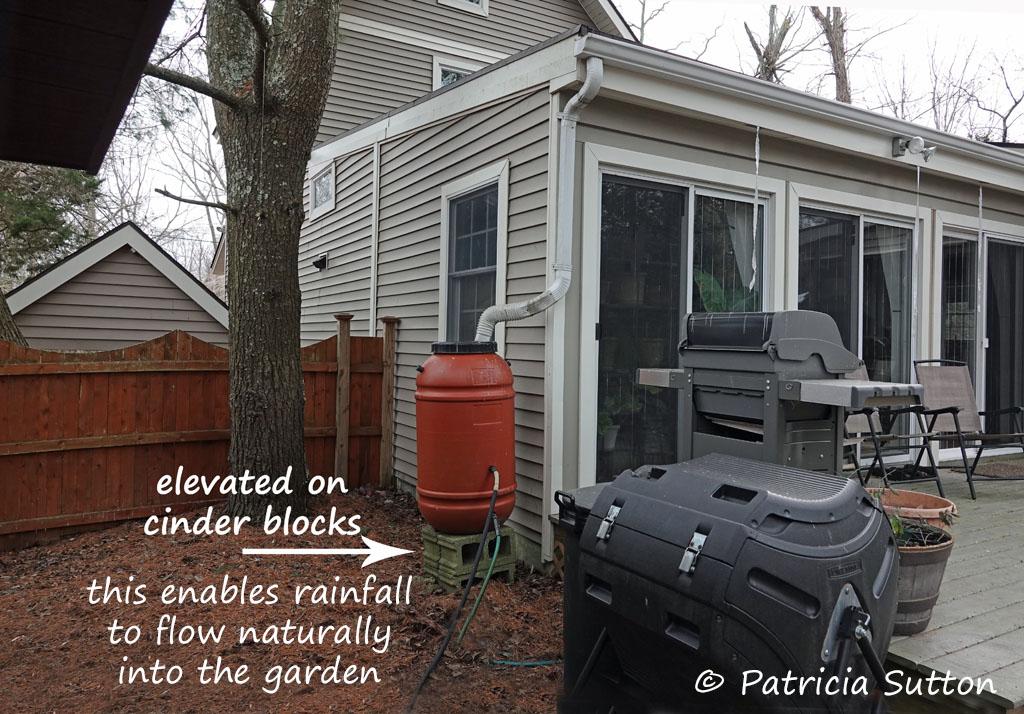
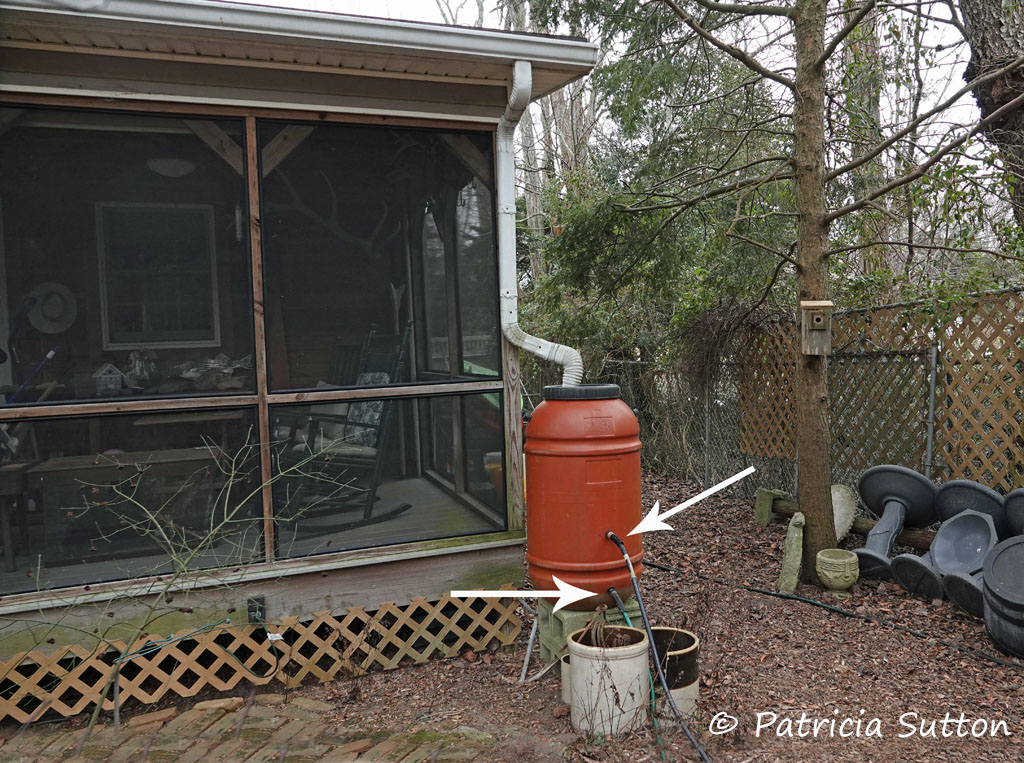
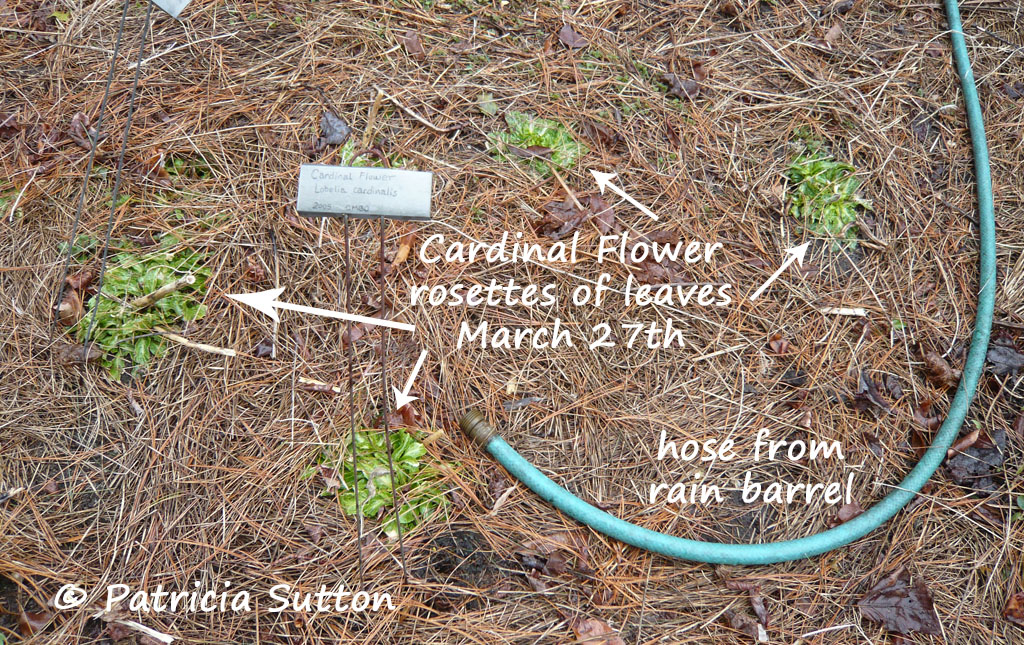

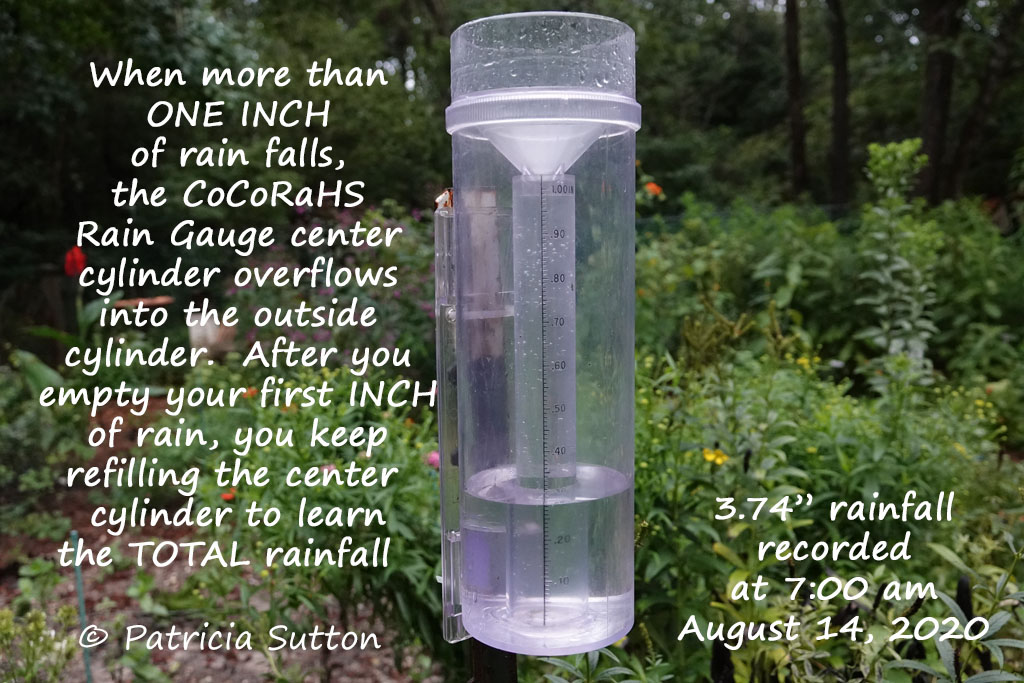
This year’s experience has shown me which natives and flowers can survive the drought the longest. One of the all-time winners has been Mountain Mint, that I planted in part shade. Some seedling hackberry trees(thank you Pat!) have been fine as well as paw paws. The butterfly weed is also alive with no extra watering.
I have been keeping a butterfly puddle damp with drippings from a rain barrel also. But, trying desperately to keep the salvias, hyssop and sunflowers going for the pollinators. It’s been tough and very disheartening.
Jeanine, thank you for sharing these details. We did lose a 5-6 year old Hackberry seedling that delighted me in 2020 when I found a number of Tawny Emperor caterpillars and one chrysalis on its leaves. Many plants have grown only half their size (or less). My stand of Tall Sunflowers (mixed into my Common Milkweed bed) are one-third their normal height and droopy. Garden Phlox, which normally blooms well into the late summer and fall is done. Cutleaf Coneflower, Rudbeckia ‘Herbstsonne’ (a hybrid between R. laciniata and R. nitida), is still blooming and has responded to watering with more buds and blooms. May we get the predicted rains on Tuesday, September 6th.
We have a well and water every day, and still the plants were traumatized by the intense heat all summer. In spite of that, we have more butterflies, dragonflies, birds and nests than ever before. (Other pollinators did not fare as well.)
What worked for us:
1) Butterflies: biodiversity of host plants and nectar plants.
2) Bees: partridge pea, vegetables, hyssop, pye weed, culver’s root and coneflowers.
3) Birds: fresh water in bird bath twice daily, caterpillars, and now seeds.
The plan for next summer: increase quantity of nectar flowers, parsley, dill, and swamp milkweed.
Yes Maria, with the intensity of relentless heat (day & night) ALL summer and so little rain, even watered wildlife gardens struggled. This new normal (if that is what it is), is very scary!
You have been taught and learned well! Keep at it with the diversity that you are providing (native plants that are not only nectar plants, but host plants too), providing native plants that cover all the seasons (some blooming in early, early spring; others blooming in late spring; others blooming in early summer, mid-summer, late summer, early fall, mid-fall, and late fall until the frost), and of course providing fresh water. Thanks so much for sharing!
I’ve lived in Waretown for 25 yrs. I started my natural habitat backyard then as well as Jersey Friendly yard. I went to empty lots and dug up flowering weeds. It’s paid off in drought times. I’ll have to use my planet identity app. I have yellow ‘cup like” flowers on top of a long stem. Hummers and bees are enjoying them. I also have white clustered, very fine blooms on a long stem. Many bees on that. My beauty berry bushes have the berries turning purple. The birds by December strip them clean. Golden rod is blooming. All of these things seem to be drought resistant so I have color and pollinators in my yard. I did see a caterpillar on my milkweed. I have wild honey suckle the monarchs and swallow tails have been on. Small solid yellow butterflies around too. Some orange/ brown butterflies on coneflowers when they had petals. I’d love to have the time to watch and identify everything. Maybe some of this info will be helpful. I attended the conference at the college a few years ago and have registered for the next one. Very informative. I do recommend it.
Hi Pamela, We are so lucky to have so many reputable native plant nurseries now too. That wasn’t the case when I began my wildlife habitat in 1977 (45 years ago). It is definitely a good thing to support these native plant nurseries so that they are here long term. It can be tough to survive as a native plant nursery, when everyday nurseries are full of exotic plants in full flower that steal the show. Thanks for sharing, Pat
Thanks for a lovely blog post! So much great information! We’ve been lucky and only a my steeple bush and two great blue lobelias suffered. I did little to no watering of my native plants although we’ve been watering the trees and shrubs we just planted this spring on a weekly basis.
We have silt loam and I think this helps retain moisture and luckily my plants get some shade either in the morning or late afternoon.
I am raising monarchs, tiger swallowtails, variegated fritillaries and black swallowtails and I am blessed to still have food (native plants) to feed them.
I love the rain barrel idea. Do you have any tips or tricks on how to make one? I’ve been thinking of adding a few because we are on well water. How did you get the downspout hooked up to the barrel?
Hi Kirsi, we purchased our rain barrels (they were repurposed olive oil barrels) and they were already fitted with a fine mesh screen on top (so mosquitoes can’t breed in it), a lid that screwed down to hold the screen in place, and a number of sites where hoses could be screwed into it so that the accumulated water could empty slowly out into our garden. A regular hardware store carries gutter sections that you can attach to your current gutter so that it empties just above your rain barrel. Rain barrels are so popular now that many many environmental organizations and nature centers offer Rain Barrel Making Workshops. Why don’t you goggle it and see what you can find near you and/or call your local Audubon Center and see if they can direct you to such a workshop. Here’s one such workshop when I googled it: https://njwatersavers.rutgers.edu/MunicipalGuideforRainwaterHarvesting/ForMunicipalities_GuideRainwaterHarvesting_1BuildaRainBarrelWorkshop.html
Here’s a suggestion for putting otherwise wasted water to use. If you have a whole house air conditioner it’s amazing how much water is produced by condensation. We only have a 1200 sq ft house and we drip into a 5 gal bucket we empty twice a day. It’s great for anything in pots or plants too far or secluded for a hose.
Hi Lynn, thanks so much for sharing this tip! Pat